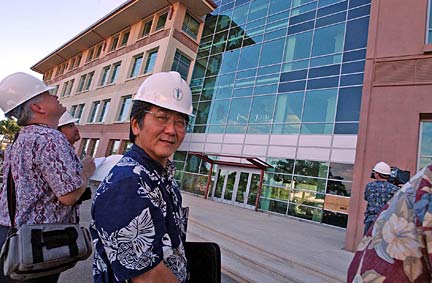
|
UH medical school
struts to attract
the right faculty
Hawaii's hopes of developing a biotechnical industry associated with the medical school nearing completion in Kakaako depend on more than a new building, say movers and shakers in the field nationally.
As the University of Hawaii John A. Burns School of Medicine is expanding faculty, "the first trick is to be very hard-nosed and pick only the best of very bright people," Dr. Irving Weissman, Stanford University professor of pathology and developmental biology, said in an interview.
Weissman, 2002 California Scientist of the Year, who was the first to identify and isolate stem cells in any species, is among more than 300 distinguished researchers attending yesterday and today's Hawaii Bioscience Conference at the Hawai'i Convention Center.
The medical school sponsored the intensive two-day meeting to celebrate the opening of the first building in the $150 million complex at Kakaako and "to showcase what we are doing in Hawaii," said Dr. Edwin Cadman, the school's dean.
The first classes will be held in the education building in April, and scientists will move into the research building in August or September, Cadman said.
The list of speakers and guests at the conference reads like a "who's who" in bioscience.
"These are academic opinion-makers in research and technology throughout the country," Cadman said, adding that he hopes "they will go back to their respective institutions and tell them what we're doing in Hawaii.
"We're hoping to get entrepreneurial faculty to start up small companies."
Weissman, Dr. Gerald Crabtree, also a professor of pathology and developmental biology at Stanford, and Tom Humphreys, co-founder and former chairman of Hawaii Biotech in Aiea, provided some tips on how to accomplish that goal.
Weissman, whose laboratory has led to creation of several companies on Stanford's campus, said the medical school should focus on providing an atmosphere for outstanding researchers to talk to each other and attract high-caliber graduates and postdoctoral researchers.
Scientists described state-of-the-art developments in genomics yesterday and discussed what is ahead in applying the new knowledge to predict, prevent and treat diseases.
In a keynote luncheon speech, Nobel Laureate Michael Bishop, chancellor and professor of microbiology and immunology at the University of California-San Francisco, said progress toward cancer prevention has been hampered by inability to identify causes of the complex disease.
But there is hope in the war against cancer, he said.
Scientists are "rapidly accumulating genetic fingerprints of cancer," allowing them to identify individual cancer genes in tumors, he said.
He said it is unlikely that there will ever be one cure for cancer, but with genetic profiles of cancer, treatments could be tailored to specific properties of cancer cells. That is already occurring with some types of cancer and other diseases, he said.
[News] [Business] [Features] [Sports] [Editorial] [Do It Electric!]
[Classified Ads] [Search] [Subscribe] [Info] [Letter to Editor]
[Feedback]
